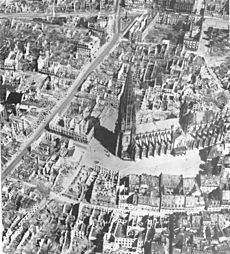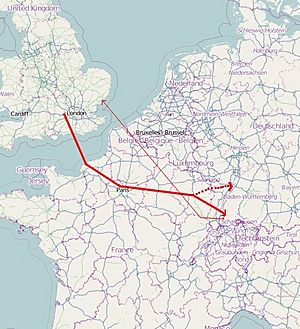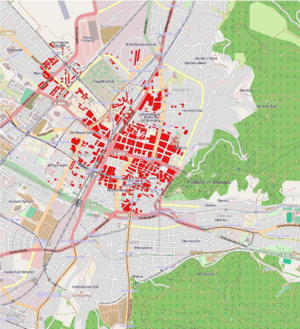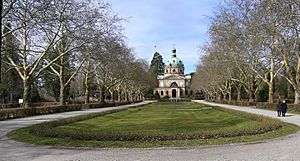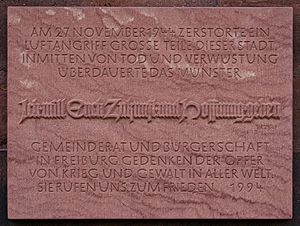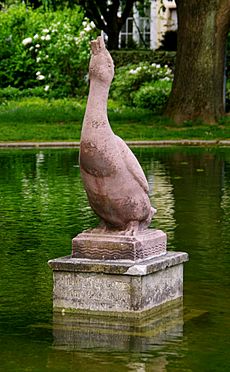Operation Tigerfish facts for kids
Operation Tigerfish was the secret code name for a big air raid during World War II. On the evening of November 27, 1944, the Royal Air Force bombed the German city of Freiburg. This attack sadly caused about 2,800 deaths.
The name Tigerfish was chosen by Air Vice-Marshal Robert Saundby. He loved fishing and gave all German cities that were targets for heavy bombing a "Fish code" name. Saundby was the assistant to Air Chief Marshal Arthur Harris, who was in charge of RAF Bomber Command.
Contents
Why Freiburg Was Targeted
| Date of air raid |
Number dropped bombs |
|---|---|
| 10.05.1940 | 69 |
| 03.10.1943 | 12 |
| 07.10.1943 | 7 |
| 09.09.1944 | only on-board-guns |
| 10.09.1944 | only on-board-guns |
| 12.09.1944 | 2 |
| 29.09.1944 | only on-board-guns |
| 07.10.1944 | only on-board-guns |
| 08.10.1944 | only on-board-guns |
| 03.11.1944 | 8 |
| 04.11.1944 | 21 |
| 21.11.1944 | 15 |
| 27.11.1944 | 14.525 |
| 02.12.1944 | 34 |
| 03.12.1944 | 49 |
| 17.12.1944 | 74 |
| 22.12.1944 | 5 |
| 25.12.1944 | only on-board-guns |
| 29.12.1944 | 13 |
| 30.12.1944 | 47 |
| 01.01.1945 | 32 |
| 04.01.1945 | 10 |
| 15.01.1945 | 59 |
| 08.02.1945 | 248 |
| 10.02.1945 | 44 |
| 13.02.1945 | 1 |
| 18.02.1945 | 18 |
| 21.02.1945 | 7 |
| 22.02.1945 | 36 |
| 24.02.1945 | 20 |
| 25.02.1945 | 1024 |
| 26.02.1945 | 79 |
| 28.02.1945 | 1861 |
| 04.03.1945 | 53 |
| 13.03.1945 | 24 |
| 16.03.1945 | 1801 |
Freiburg was first accidentally bombed by German planes on May 10, 1940, killing 57 people. After that, the city was mostly safe from attacks until October 1943. People in Freiburg hoped they would avoid a major bombing. The city was not seen as a main target by the Allies for a long time.
In autumn 1943, the Allies dropped leaflets in northern Germany. These leaflets suggested that people who had lost their homes could move to Freiburg. This was meant to encourage refugees to go there, but it didn't work.
Small bombings began on October 3, 1943. For example, on October 7, 1943, U.S. Air Force planes bombed the city's railway facilities. On April 1, 1944, U.S. bombers were supposed to attack Ludwigshafen. Instead, they mistakenly bombed the Swiss city of Schaffhausen.
Later, on November 3, 1944, the freight railway station and airfield in Freiburg were bombed by U.S. planes. Another attack happened on November 21, 1944.
Why Freiburg Became a Main Target
Freiburg didn't have many important military factories. The Allies' bombing guide in 1944 listed some companies and the gasworks as less important targets. Only the railway hub was seen as a more important target. There were no purely military targets mentioned.
However, Freiburg became a bigger target for Allied bombers as the war front moved closer from the west. Freiburg was important for moving troops because of its good location on the Rhine Valley Railway and the Freiburg–Colmar railway. In 1943, the Allies believed that German forces could move many divisions of soldiers from the Eastern Front to the Western Front using these railways.
Because of this, General Eisenhower ordered attacks on railway and transportation centers on November 22, 1944. After an American daylight attack on Offenburg, the British were told to bomb Freiburg the next day. Since Freiburg's transport links were close to homes, it was considered suitable for "carpet bombing." This type of bombing aimed to destroy large residential areas. The mission order clearly stated that the goal was to destroy the city and its railway system.
The Attack on November 27, 1944
The bombing on November 27, 1944, was carefully planned. Fifty-nine de Havilland Mosquito planes from the No. 8 Pathfinder Group led the way. They used a special navigation system called Oboe from France. The main target point was the intersection of Habsburgerstrasse and Bernhardstrasse.
First, the target area was marked with red lights. Then, the order was given to add even more red and green lights. A "master bomber" guided the marking and bombing. If pilots couldn't hear the master bomber, they were told to drop as many bombs as possible. They were instructed to drop bombs first on red, then red and green, then green, and finally on yellow markings.
Between 7:58 PM and 8:18 PM, 292 Lancaster bombers from No. 1 Group RAF carried out the attack. They dropped 3,002 explosive bombs (weighing 1,457 tons) and 11,523 incendiary bombs (weighing 266 tons). Only one Lancaster bomber was lost, but the reason is still unknown.
Aftermath of the Bombing
Casualties and Population Change
The bombing resulted in 2,797 deaths and about 9,600 injured people. Famous people who died included the theologian Johann Baptist Knebel, artist Hermann Gehri, and astrologer Elsbeth Ebertin.
After the bombing, many people left Freiburg. By December 31, 1944, the population was 63,962. It reached its lowest point of 57,974 people in late April 1945. The city's population didn't return to its original size until early 1950.
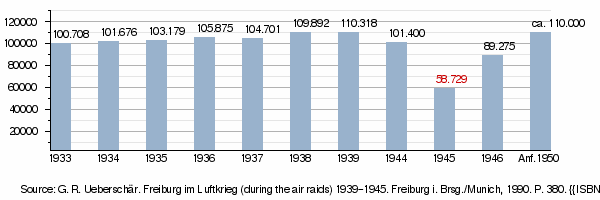
Destruction in the City
The historic old town was almost completely destroyed. Parts of the suburbs like Neuburg, Betzenhausen, Mooswald, and northern Stühlinger were also heavily damaged. About 30% of all homes were destroyed or badly damaged. Many businesses, like Hüttinger Elektronik and M. Welte & Söhne, were wiped out.
Many old and important buildings were destroyed in the attack. Luckily, almost all of them have been rebuilt. These include:
- Old Church St. Louis (from the 13th/19th century)
- Church of St. Martin (from the 14th century)
- St. Conrad (built in 1929, one of the first concrete churches)
- Gerichtslaube (court loggia, 14th century)
- Basler Hof (1494/96)
- Kornhaus (grain house, 1498)
- Zum Walfisch (1514/16; only the front and bay window survived)
- Old town hall (1557/59)
- Peterhof (1585/87)
- University Church (17th century)
- St. Michael's Chapel (18th century)
- Deutschordenskommende (1768/73)
- Palais Sickingen (1769/73)
- Charles's barracks (1773/76)
- Collegium Borromaeum (1823/26)
- Culture and Festival Hall at the city garden (built in 1854)
- City Theatre (1905/10)
- The main train station, including its tracks and power lines
- Bertoldsbrunnen (a fountain from 1806)
The city's famous landmark, the Freiburg Minster (cathedral), was only slightly damaged.
Remembering the Event
Freiburg remembers the victims of November 27, 1944, with various memorials and regular events.
Memorials Around the City
- Tomb at the Main Cemetery: 1,664 victims of the bombing are buried in a special tomb and other graves at Freiburg's main cemetery. This site was opened on November 27, 1958.
- War Memorial at the Main Cemetery: Near the main cemetery's hall, a cross with a statue called "The Mourner" remembers all war victims. It was put up on October 18, 1951.
- Plaque on Freiburg Minster: On the west tower of the Freiburg Minster, a plaque remembers the victims. It also points out how little damage the cathedral received compared to the rest of the city. This plaque was placed in 1994 for the 50th anniversary.
- Drake Statue: It's said that a drake (male duck) in the city park warned people before the bombing. A statue of a drake was made and given to the city in 1953.
- Crucifix in Deutschordensstraße: A crucifix here, placed in 1963, has an inscription. It mentions that the nearby church was destroyed in the 1944 attack, and the cross was damaged.
- University Hospital Plaque: A plaque at the main entrance of the University Hospital says it was "Destroyed by enemy action on 27 November 1944, built again in 1945 -1953."
- M. Welte & Sons Plaque: A plaque on a building on Lehener Straße 11 remembers the destruction of the M. Welte & Sons company.
- Main Post Office Plaque: At the main post office, a plaque tells its history. It mentions that 99 postal workers died when the building was destroyed in the 1944 attack. Inside, a large relief lists their names.
- University Memorial: In front of the College Building II of Freiburg University, two stone slabs remember the city and Minster being saved on November 27, 1944, and also remember the synagogue.
- Bertoldsbrunnen Fountain: The new Bertoldsbrunnen fountain, built in 1965, has an inscription. It notes that it was built where the old fountain, destroyed in 1944, once stood.
- Jurgen Goertz Figure: For a short time in 1979, a tall wooden figure by artist Jurgen Goertz was displayed on Kaiser-Joseph-Straße. It was a memorial to the city's destruction.
- Schlossbergsteg Reliefs: On the footbridge to Castle Mountain, there are concrete reliefs by Emil Wachter from 1979. They show images related to the bombing, like planes dropping bombs and the burning city.
- Minster Tower Keystone: A text by Reinhold Schneider on the Minster tower's keystone also remembers the destruction of Freiburg.
Commemoration Events
The city of Freiburg holds a wreath-laying ceremony and other events each year to remember the bombing. For the 50th anniversary, there was a special music performance, a ceremony, and an exhibition. On November 27, 2004, events included:
- Photo Exhibition: Operation Tigerfish
- Exhibition: Air protection is necessary
- Film Screenings: Bombs on Freiburg
- Exhibition: Symbols of Remembrance
- Remembrance service
- Oratory: De Curru Igneo (a musical performance)
- Lecture: How experienced women the war on the home front?
- Media exhibition at the City Library
Also, the Hosanna bell of Freiburg Minster rings every year at the exact time of the air raid.
Other Ways of Remembering
For the 50th anniversary, the city government and a local bank issued a special medal. It featured an image of the drake statue from the city park.
Films About the Event
- Bomben auf Freiburg (bombs on Freiburg). A 63-minute documentary from 2004.
- Zerstörung, Wiederaufbau, Alltag: Freiburg 1940–1950 (destruction, reconstruction, everyday life: Freiburg 1940-1950). A 38-minute documentary from 2010.


